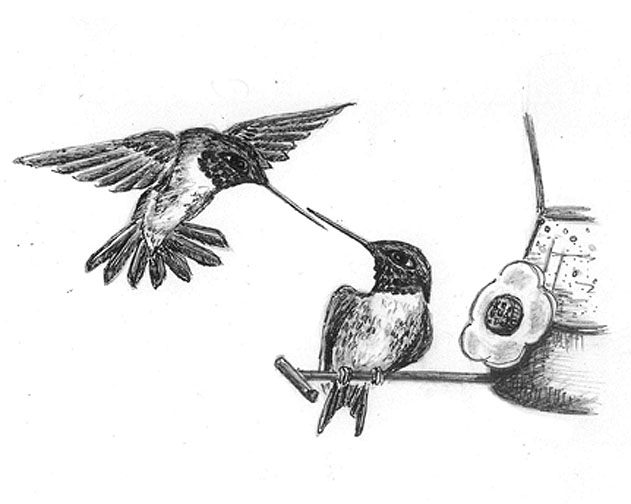
Dear Bird Folks,
All summer long we have enjoyed watching the hummingbirds coming to our feeder. But why do they spend so much time chasing each other?
– John, Brewster, MA
It’s been nuts, John,
Way back in June, when the hummingbirds were busy with their nesting duties, many folks weren’t seeing the same number of birds they remember seeing the year before. They immediately assumed something bad had happened, or that their feeders were suddenly defective or all the hummingbirds had fallen victim to the deep state. When I assured them there was nothing wrong and the birds would return in a few weeks, they doubted my response. But, just as I predicted, hummingbirds soon became very active at nearly everyone’s feeder. Those same people who doubted me are now telling everyone how smart I am. (I may have dreamt that last part.)
I think we all know that many flowers contain nectar, which is the plants’ way of attracting hummingbirds (plus bees, bats and butterflies). When the birds reach into a blossom, they (the birds) also become covered in a bit of pollen, which they then pass on to the next blossom they visit. This is how plants “mate” or are pollinated. (I don’t mean to be judgmental, but the mammal method of reproducing is way better.) How much nectar does a flower produce? Good question. I’m not really a flower guy. The only thing I know about flowers is that they are pretty, some produce a pleasant smell and if you hold one particular species under your chin, it can somehow tell if you like butter. It does appear, however, that the nectar supply is rather limited and that’s the reason why your hummers are chasing each other.
To satisfy its sugar requirement, a single hummingbird may visit over a thousand blossoms in a day. This suggests that birds gain very little from each visit and thus can’t afford to share, even when they aren’t hungry. When a bird has finished eating, it will sit on a nearby perch, rest, preen, and be ready to give the old heave-ho to any other hummer that might want to visit the same patch. This brings up the obvious question: Flower nectar may be limited, but there’s plenty of food in a feeder. Why do the birds defend it regardless? Hummingbirds can do a lot of things well. They are amazing flyers; they can hover in one spot, fly backwards, and even upside down if they want to. They also have remarkable memories. The hummingbird that fed on your feeder this summer will be back looking for that same feeder, in the same location, eight months from now when it returns from the tropics. (Although your feeders might not be there because, if you’re like me, you’ve forgotten what you did with it.) Hummingbirds have a lot going for them, except they stink at math. They don’t seem to understand the concept of volume and that the amount of food in your feeder is way more than one bird can possibly consume. Hummers see your feeder as a tiny patch of flowers with a limited food supply and thus, they guard it. They’re like a golden retriever that protects one tennis ball, even though the house is filled with forty others.
If you are concerned about seeing these hummer clashes, you could add a second feeder. A second feeder can take the pressure off the original one. Just don’t put it too close. An aggressive bird can defend two feeders as easily as one. Instead, place the new feeder on the other side of your house, or at least out of sight from the original. We have a feeder hanging off of our deck and the fighting over it is nearly nonstop. In the rare instance where I actually listened to my own advice, I also hung a smaller feeder in the back of the house. This is the peaceful feeder. Only one bird, or at least one bird at a time, uses it. It’s a far more relaxing experience. Some skeptical people might say that I’m only recommending creating a second option in order to sell more hummingbird feeders. My response to these cynical people is: Well, duh!
Every evening after work, my wife and I sit on our deck and watch the battling hummers. We actually find the skirmishes to be entertaining. Does this make us bad people? No, it doesn’t, at least not in this case. Watching birds interact at any level is what bird watchers do. Whether it’s crows harassing a hawk or a cardinal couple feeding each other, it’s their behavior that makes them interesting. And who knows, maybe one day some super-smart hummingbird, probably wearing glasses, will actually do the math and figure out that there’s enough food in the feeder to go around and the fighting will stop. It could happen.
Most of us have seen videos showing dozens of hummingbirds feeding from one single feeder. What’s going on here? Have those birds done the math? Nope. Those feeders are out west or in some location where there are crazy numbers of hummingbirds. In these cases, there are far too many birds to fight, so they are forced to share…but they aren’t happy about it. The fighting over your hummingbird feeder will end soon, John, as the birds are just about ready to leave us for the winter. But not to worry, they’ll be back in April, ready to eat from your feeder once again…if you can only remember where you put it.